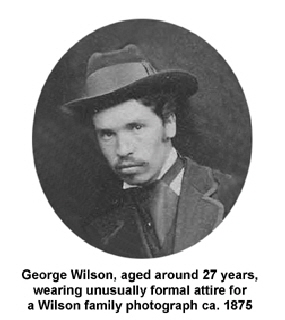 |
|||||||||
|
|||||||||
 |
|
George Wilson (1848 - 1890)
Brief synopsis
Victorian Scottish artist; born 18th November 1848 at Tochieneal, near Cullen in Banffshire, Scotland; died 1st April 1890 at Castle Park, Huntly in Aberdeenshire
George Wilson has been described as being the last of the lost and forgotten Pre-Raphaelites. But, more accurately, he was simply a strictly adherent follower of the Pre-Raphaelite ethos and principles, long after these had been abandoned by most 'followers' for more commercial values. He was never, of course, a member of the original Pre-Raphaelite Brotherhood (P.R.B.); indeed he was only born at the end of the same year in which the P.R.B. was first founded. And in fact, although he largely pursued the Pre-Raphaelite philosophy throughout his short life, that is about as far as his very differing persona would ever have permitted any such attachment to go. Whilst presumably admiring the original Pre-Raphaelites - around whose circles he certainly moved - unquestionably Wilson could never have been found within one of their cliques, nor could he ever have capitalised on any consequent success. Throughout his career, he shunned all publicity, and he exhibited only very infrequently - just twice at the Royal Academy and a handful of times spread mainly between the Grosvenor, the Dudley, Liverpool's Walker, the RGI and the RI. Similarly, only very occasionally did he sell his works - mainly to friends and a few rare patrons, and, frustratingly, he never, ever, considered signing his paintings.
The reason for this latter trait is not clear, but, from what is known of his character, it is most likely that he quite simply did not feel that either the 'stature' of his name, or the importance of his individual works, merited these being formally signed off for posterity. Other colleagues around him at that time, and many subsequent admirers of his work, would demur at this opinion - but either way, it certainly makes identification that much more difficult for anyone without reasonable experience of his work. Nonetheless, and conversely for those fortunate enough to have experienced much of his work, such a formal signature is largely superfluous, as Wilson's technique is, indeed, a clear signature in itself. At the time of George Wilson's untimely death in 1890, at the early age of 41, he was still, rather inevitably, only just approaching the height of his artistic career. Often described by his friends and colleagues as a 'born painter', Wilson was a true 'artist's artist' who painted purely because he loved to paint - almost entirely from nature, which he loved equally with the romantic poets and the classics. He interpreted the works of the latter in a small number of surviving allegorical oil paintings; but undoubtedly, his greatest love was to paint, quite exquisitely in watercolour, the woodland landscapes of his beloved native Scotland, northern Italy, and the south of England. He thus led a somewhat nomadic life, coming and going as the mood took him. Although he was born and died in Scotland, and whilst he visited his homeland every year, his working base was always London. Although undoubtedly Wilson was from 'the word go' influenced strongly by the Pre-Raphaelite ethos and, indeed, this rarely faltered over the years, there is also a perceived interest in impressionism that creeps into some of his apparently later work. This is hardly surprising, as he was clearly very interested in the work of others and certainly would regularly have come across the output of the Impressionists when passing through Paris on his way to and from Italy. When in 1899, Percy Bate wrote The English Pre-Raphaelite Painters, Their Associates and Successors, his immediately post-contemporary and benchmark commentary on the Pre-Raphaelite movement, he included George Wilson together with Simeon Solomon and Frederick Sandys in a chapter entitled The Romantic Influence. Since then, Wilson has been virtually entirely forgotten - and there are many reasons for this. Shortly after the publication of Bate's book, and over a decade after George Wilson's death, he was heralded in 1903 through a retrospective exhibition at the John Baillie Gallery in London, as already being recognised as the first amongst the 'Neglected Artists' of the era. Because of the scarcity of his work and previous dearth of any greater information about his life, most modern day writers have relegated him - albeit reluctantly perhaps - to being a long lost enigma. However, most would equally still agree that he was an important, if illusive, figure in Victorian painting, and that a full study of his work is well overdue. This aim has now been achieved, in so far as is presently practicable, via the new book: The Lost Pre-Raphaelite - George Wilson; His Life, Work and Associates. Please follow this link to the online bookshop in order to access this title. A number of sample pages are available from the book to give a broader flavour of the contents. Again, please follow the highlighted link to access these PDF files. You will need Acrobat Reader to read the files, available to download from there if you do not already have it. Elsewhere on this site, by following the highlighted link, there is a selection of images of paintings by George Wilson, with an additional link to a number of previously recorded but now lost images of Wilson's work, which may help to identify the position that this artist filled in relation to the broader artistic world of his time. As a rather more ambitious possibility, these latter pictures might even help some fortunate owners to identify the artist and title of some long-obscure work that hangs on their walls. Please use the following link to continue to read a short online biography of George Wilson
|






